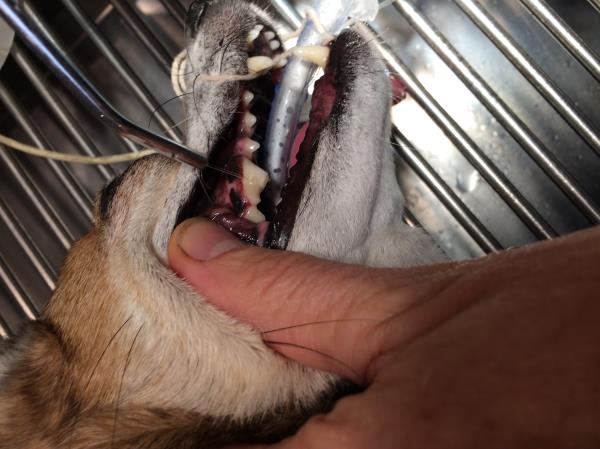Gum Disease – Veterinary Periodontics
According to the American Veterinary Dental Society, more than 80 percent of dogs and 70 percent of cats develop gum disease by the age of three years.
Periodontal disease is the most common condition animal dentists see affecting dogs and cats. Infection and inflammation of the gums and supporting tissues of the teeth are caused by bacteria present in plaque and calculus (tartar).
Dog dental care and Cat dental care to keep the teeth clean is therefore of great importance. Your veterinarian may recommend an oral hygiene program that includes regularly brushing your pets’ teeth with a toothpaste formulated for animals. (they can’t rince out the human tooth paste)
Dr Phil encourages all new puppies and kittens to start off on a pet dental care program – often just a simple wiping of the tooth gum margin of the upper teeth with tissue or a soft cloth ! It makes such a difference to the animals dental health in advanced years .
Diet is factor in the development of plaque and calculus on pets teeth. Soft or sticky foods should therefore limited, while certain chewing toys are beneficial. A specially formulated diet with dental benefits (reduced accumulation of plaque and calculus) is now available for dogs and cat.
Regular dental check-up visits to your veterinarian are done with the regular vaccination- that easy!
Hardened tartar should be removed by your veterinarian, as this requires the use of special instruments and equipment.
Routine periodontal treatment performed by a veterinarian dentist typically includes ultrasonic scaling, subgingival manual scaling, and polishing. Almost all dental procedures in pets, including scaling and polishing, are performed under general anesthesia.
NOTE !!C The current veterinary anesthesia is such, that this poses minimal risk. The adverse effects of bad teeth on the overall health of the animal also greatly outweigh the anesthetic risk !!
There are clear indications that oral health status has a profound effect on the animal’s general health. Periodontal disease cause’s bacteria and toxins to enter the bloodstream with potentially deleterious effects on internal organs like Heart, Kidneys and liver. Interesting , poor systemic health, or non dental disease may manifest in the oral cavity in various ways and may also exacerbate periodontal disease. eg kidney disease.
Your pet’s dental examination is therefore not limited to the oral cavity but always includes a general physical examination. Laboratory examinations, to evaluate systemic disease concerns, are also commonly performed. Some dogs and cats suffer from chronic oral infection or stomatitis, a poorly understood condition which is frustratingly difficult to treat.
Does my dog or cat get cavities and need fillings?
Tooth decay or caries, as seen in man, is uncommon in dogs and cats. Enamel fractures and small lesions in the teeth are repaired using dental composites as human dentists do. It is a cheaper procedure than taking out the tooth.
Cats, however, are prone to developing a different type of cavity, known as a resorption lesion or FORLS (feline osteoclastic resorptive lesions) These poorly understood lesions often begin at, or below the gumline. Red, inflamed gums around an affected tooth, and pain are early signs that can be noticed by the pet owner. These lesions require immediate veterinary care.
Dental fractures are very common in the dog, especially those fed large bones – and dental treatment is mandatory if pulp exposure has occurred. The exposed pulp is not only very painful, but also becomes necrotic; the formation of a periapical granuloma or “tooth abscess” is also possible.
Veterinary Endodontic treatment (commonly referred to as root canal treatment) is now performed by veterinary dentists. Subsequent to endodontic treatment, the root canal opening is filled with a dental sealant. For the root canal therapy to be successful the affected tooth needs to be treated before infection fills the pulp and reaches the root. Dr Phil hardly ever does root canal therapy for the following reasons
- The cases are usually presented days after the pulp exposure
- There is a complication rate
- Our pets are often better off with the tooth removed and they are guaranteed no pain and infection down the line – which can be difficult to detect.
- The reluctance of owners to make multiple vet visits.
- The costs of a root canal or extraction are similar excluding radiographs

Above: Vet dentist – doing a “filling” in a dog
Crown restoration, for which various techniques exist, is also available. In selected cases, other methods of fixed prosthodontics, such as a bridge, may also be considered
A greater awareness of dental disease in the dog amongst veterinary practitioners and pet owners will greatly contribute to the early recognition and prevention of dental problems, in particular periodontal disease. This is important, because periodontal disease may have a serious impact on a pet’s well-being and general health. Great advances have been made in veterinary dentistry and a wide spectrum of dental therapeutic options are now available.
